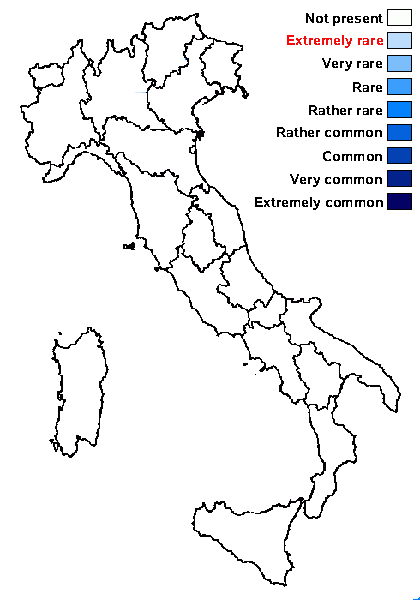Micarea deminuta Coppins
Bibl. Lichenol., 58: 58, 1995
Synonyms:
Distribution:
Description: Thallus crustose, usually poorly developed and hardly evident, effuse, whitish grey to green-grey, often covered by olivaceous, subgelatinous colonies of non-lichenized algae. Apothecia micareoid, black to brown-black, epruinose, sessile, 0.08-0.2(-0.3) mm across, convex to subglobose, without a distinct proper margin. Proper exciple not evident, even in young apothecia; epithecium patchily brown, K+ olivaceous green, N+ red; hymenium colourless or with dark brown, K+ olivaceous green streaks, 30-50 µm high; paraphyses scanty, of two types, a) unbranched, hyaline 0.8-1.5 µm thick, b) branched and sometimes anastomosing t, concentrated into small fascicles, coated throughout by dull brown pigment, (1-)1.2-2 µm thick, the apical cells not capitate but sometimes widening to 3 µm; hypothecium dark reddish brown, K- or K+ brown, N+ pale red, the upper part K+ olivaceous green, N+ red, (60-)70-95 μm high. Asci 8-spored, clavate to cylindrical-clavate, in K/I with a blue outer layer and apical dome and unstained wall, the dome with an apical cushion, 30-40 x (8-)11-15 μm. Ascospores 1-celled, hyaline, ellipsoid, (6-)7.5-10(-11.8) x (3.2-)3.5-5(-6.5) µm. Pycnidia partly immersed to sessile, c. 60 µm across, the wall brown and N+ pale red, olivaceous green and N+ red around the ostiole. Mesoconidia (5-)5.5-8.1 x 1.5-1.8 μm; microconidia bacilliform, 4.5-5.7(-6) x 1-1.5 μm . Photobiont micareoid, the cells 5-8 μm wide. Spot tests: K-, C-, KC-, P-, UV-. Chemistry: thallus without lichen substances. Note: mostly on logs and rotting stumps; widespread in Europe, but not common, with a few records from the Eastern Alps (Carinthia, Austria); to be looked for in the Italian Alps.
Growth form: Crustose
Substrata: lignum
Photobiont: green algae other than Trentepohlia
Reproductive strategy: mainly sexual

Predictive model
Growth form: Crustose
Substrata: lignum
Photobiont: green algae other than Trentepohlia
Reproductive strategy: mainly sexual

Predictive model
 INDEX FUNGORUM
INDEX FUNGORUM
 GBIF
GBIF

